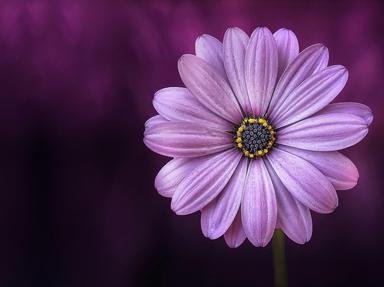Quiz Answer Key and Fun Facts
1. This plant, which produces long magenta-violet spikes, can be found in the wild, where it can become extremely invasive and destructive. Varieties grown for home gardens are cultivated to be less invasive. Its name derives from its use as a medicinal herb.
2. This charming perennial has silver-grey foliage and clusters of tiny yellow flowers (hence its name). When the flowers fade, the seed pods resemble tiny silver-dollar plants. Once planted, it should never be transplanted.
3. An unusually shaped white variety of this flower is called "Dutchmans Britches". Most people are more familiar with the pink or pink and white varieties. In England, the flowers are called "Lady in the Bath". However in America, they are given a more romantic name.
4. "Shasta", and "Montauk" are cultivated varieties of this common and ever-popular flower, of which the "Ox-Eye" variety is found abundantly in the wild.
5. This popular flower makes an appearance in the film version of "The Wizard of Oz", and is associated with Memorial Day in the U.S. It comes in various shades of pink and peach, as well as white, though the bright red variety is still the best known. All have the same black center, with its velvety "star". It is illegal to grow one variety in some parts of the world because of its use as a drug.
6. The "Blue Bonnet" variety of this majestic perennial, whose flowers grow in tall thick spikes, is the state flower of Texas. It is a member of the pea family, and its name is derived from the Latin word for "wolf".
7. Also called "Blanket Flower", this plant produces flowers with brown centers and jagged-edged petals with yellow edges and orange-brown centers.
8. Also called "Tickseed", the most common variety of this plant has large yellow flowers with yellow centers and pinked edges. However, there are dwarf varieties with tiny yellow or pink flowers and finely divided leaves.
9. Plants of this family include the florist's Carnation. In the perennial border, you are more likely to find smaller-flowered varieties with silver-grey foliage. They are also known as "Pinks".
10. Daylilies are members of the Liliacae family; what is their botanical name?
11. Gloriosa Daisies and the wildflowers known in the U.S. as Black-Eyed Susan (in the U.K. this name is given to an orange variety of Thunbergia) belong to this family, named for the shape of their center "button".
12. Aquilegias are beautiful, intricately shaped flowers; they come in a variety of colors from yellows and oranges to blues and violets and frequently combine more than one shade of color in the same blossom. Their Latin name means "eagle". What is their more common name, which means "dove"?
13. Michaelmas Daisies, which look especially charming combined with Goldenrods, are perennial members of this family, whose name means "star" in Greek.
14. This unusual perennial produces silvery, flocked foliage and flowers of a contrasting deep magenta-purple (though cultivated varieties come in a variety of shades, from white to red). It is sometimes found in the wild.
15. Plants of this type include "The Pearl" (which looks rather like "Baby's Breath"), "Coronation Gold", and the beautiful "Moonshine", which combines silver-grey foliage with flat heads of pale yellow flowers. In the wild, its colors are usually white or magenta with very fine, feathery foliage. Because of its medicinal use, it is sometimes known as "Nosebleed".
Source: Author
jouen58
This quiz was reviewed by FunTrivia editor
Bruyere before going online.
Any errors found in FunTrivia content are routinely corrected through our feedback system.


